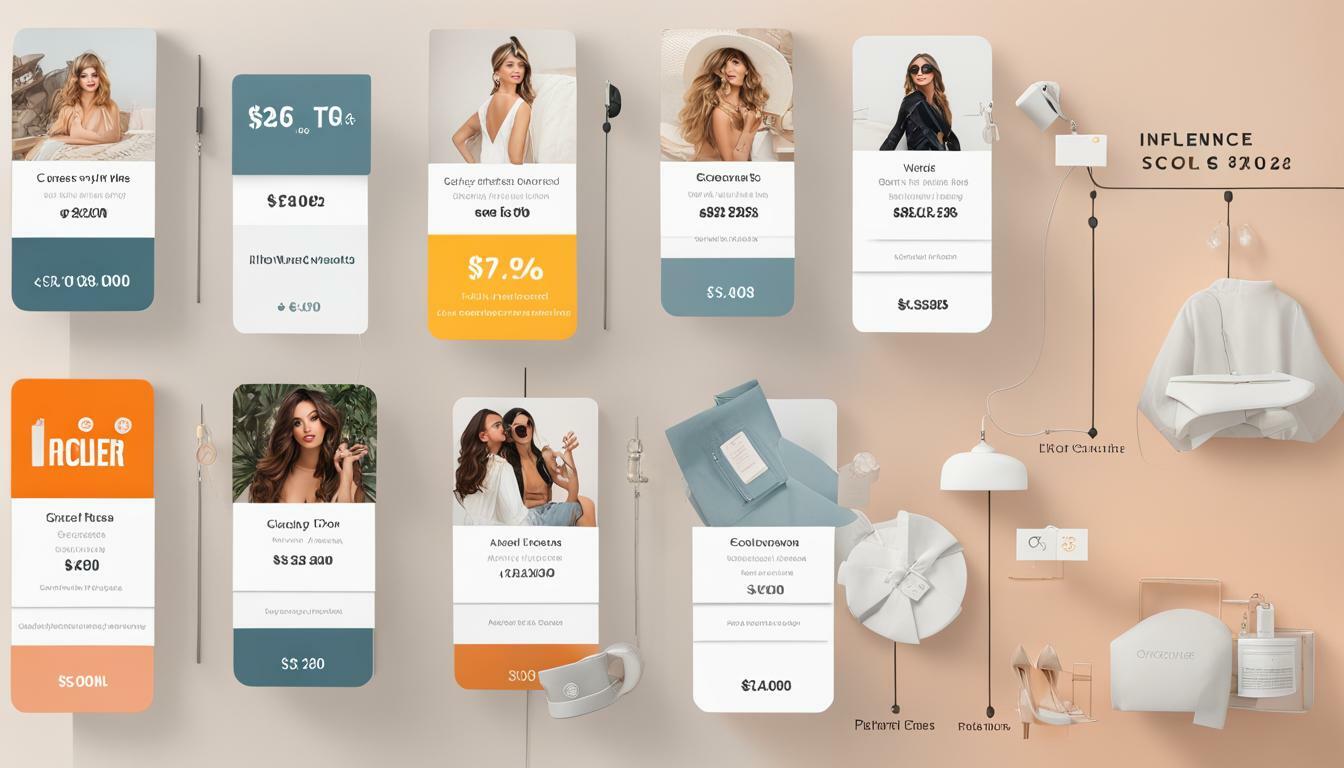So, you’re planning an influencer marketing campaign and wondering how much it’s going to cost you. Well, you’ve come to the right place. Understanding the concept of an influencer rate card is crucial to navigating the world of influencer pricing and fees.
Social media influencers have become a valuable marketing resource for businesses of all sizes. However, negotiating influencer fees can be a daunting task, with rates varying significantly depending on the influencer’s niche, audience size, and engagement rates.
In this article, we’ll explore the influencer rate card, what it is, and why it’s essential for successful influencer marketing campaigns. We’ll also provide insights into the various pricing models used by social influencers and offer tips for businesses navigating the world of influencer pricing.
Key Takeaways:
- An influencer rate card is a document that outlines an influencer’s fees for sponsored content and collaborations
- Understanding the influencer rate card is crucial for businesses navigating the world of influencer marketing prices and fees
- Factors that influence influencer pricing include follower count, engagement rates, niche expertise, and platform popularity
- There are various pricing models used by social influencers, such as cost per post and cost per thousand followers (CPM)
Decoding Influencer Pricing: Understanding the Influencer Rate Card
So, you’re interested in influencer marketing? Great! But before you start collaborating with influencers, it’s crucial to understand the influencer rate card and how it works.
An influencer rate card is a pricing guide used by social media influencers to communicate their rates. Pricing varies depending on the influencer’s popularity, niche expertise, and engagement rates. Typically, the more followers an influencer has, the higher their rates will be. But that’s not always the case.
To accurately estimate the cost of collaborating with an influencer, you must first understand the factors that influence their pricing. The influencer rate card is a valuable tool in this regard.
| Factor | Description |
|---|---|
| Follower count | The number of followers an influencer has on their social media platforms. |
| Engagement rates | The percentage of an influencer’s followers who regularly and actively engage with their content. |
| Niche expertise | The influencer’s area of expertise, such as beauty, fitness, or travel. |
| Popularity | The influencer’s popularity on their social media platforms and the level of demand for their services. |
Armed with this knowledge, you can estimate the cost of collaborating with an influencer by referring to their rate card. Rate cards typically include the influencer’s fees for different types of collaborations, such as sponsored posts, affiliate marketing, and product reviews.
However, keep in mind that influencer pricing is not set in stone. You can negotiate rates with influencers to establish mutually beneficial collaborations. Some influencers may even be open to creative payment structures, such as receiving a percentage of sales generated from their collaborations.
Now that you have a firm understanding of the influencer rate card and the factors that influence pricing, you’re well on your way to successfully navigating the world of influencer marketing.
Influencer Rate Card Examples: Real-Life Cost Insights
Now that you understand the importance of the influencer rate card and how it works, let’s take a look at some real-life examples of influencer costs.
| Influencer | Followers | Collaboration Type | Cost |
|---|---|---|---|
| @beautybybda | 100K | Single Instagram Post | $1,500 |
| @fitnessguru | 500K | YouTube Video | $5,000 |
| @foodiefinds | 50K | Instagram Reel | $800 |
As you can see, the cost of collaborating with influencers varies widely depending on several factors, including their follower count and the type of collaboration. Keep in mind that these rates are just examples, and you may encounter different rates in your own influencer marketing campaigns.
Remember, the cost of working with influencers should be viewed as an investment in your brand’s marketing strategy.
When determining whether to work with a particular influencer, it’s important to consider the return on investment (ROI) that their collaboration will provide. Look for influencers who align with your brand values and have a strong engagement with their followers.
Furthermore, negotiating rates with influencers can be an effective way to get the most out of your budget. Don’t be afraid to communicate your needs and budget constraints to the influencers you work with.
In the next section, we will explore some practical tips for navigating the influencer rate card and establishing successful collaborations.
Influencer Rate Card Examples: Real-Life Cost Insights
Ready to get down to brass tacks and see some real-life examples of influencer rates? We’ve got you covered.
First up, we have the fashion influencer @StyleBySally, who boasts a following of 200,000 on Instagram. Her rate card shows that she charges $2,000 for a single sponsored post and $5,000 for a week-long collaboration.
| Influencer | Followers | Cost per post | Cost per week |
|---|---|---|---|
| @StyleBySally | 200,000 | $2,000 | $5,000 |
| @FitnessFrenzy | 50,000 | $500 | $1,500 |
| @VeganVibes | 100,000 | $1,000 | $3,000 |
Next, we have fitness influencer @FitnessFrenzy, with 50,000 followers on Instagram. Her rate card shows that she charges $500 for a single sponsored post and $1,500 for a week-long collaboration.
Lastly, we have vegan influencer @VeganVibes, with 100,000 followers on Instagram. Her rate card shows that she charges $1,000 for a single sponsored post and $3,000 for a week-long collaboration.
As you can see, influencer fees can vary greatly based on the influencer’s following and niche expertise. It’s important to do your research and find an influencer whose audience aligns with your brand and campaign goals.
“It’s not about finding the cheapest influencer, it’s about finding the right one.”
Keep in mind that these rates are not set in stone and can be negotiated based on the nature and duration of the collaboration. Don’t be afraid to speak to influencers and work out a mutually beneficial arrangement.
Now that you have a better understanding of influencer costs, it’s time to start collaborating and make your mark on the social media scene!
Navigating the Influencer Rate Card: Tips for Successful Collaborations
So, you’ve done your research on influencer rates, and now you’re ready to collaborate with a social media influencer. But how can you ensure a successful partnership while navigating the world of influencer marketing rates and fees? Here are some tips to keep in mind:
Set Clear Campaign Objectives
Before approaching any influencers, ensure you have a clear understanding of your campaign objectives and target audience. This will help you identify the right influencers to work with and establish realistic goals for the collaboration. Be transparent about your expectations for content, timelines, and outcomes.
Establish Authentic Connections
Building authentic connections with influencers is key to ensuring success. Take the time to research and follow potential influencers on their social media platforms. Engage with their content, share their posts, and comment on their updates. By establishing a relationship beforehand, you’ll have a better chance of securing a collaboration.
Measure Effectiveness
Measuring the effectiveness of your collaboration is crucial to determine ROI and make informed decisions for future campaigns. Establish metrics to track engagement, traffic, and conversions. Use unique tracking links or discount codes to monitor sales generated from the collaboration. Analyze the data to identify what worked and what could be improved.
Manage Relationships and Evolving Rates
Relationship management is key to building long-term partnerships with influencers. Keep in touch with your collaborators, offer feedback and support, and maintain a positive relationship. Also, be aware that influencer rates can change over time, especially if their following grows or their niche expertise evolves. Stay updated on industry trends and adjust your budget accordingly.
By keeping these tips in mind, you can navigate the influencer rate card landscape more confidently and ensure successful collaborations with social media influencers.
FAQ
Q: What is an influencer rate card?
A: An influencer rate card is a document that outlines the pricing and fees charged by social influencers for collaboration and sponsored content. It helps businesses understand how much influencers charge for their services.
Q: Why is it important to understand influencer pricing?
A: Understanding influencer pricing is crucial for successful influencer marketing campaigns. It allows businesses to budget effectively, find the right influencers within their price range, and ensure a positive return on investment.
Q: What factors influence influencer pricing?
A: Influencer pricing is influenced by various factors, including follower count, engagement rates, niche expertise, and platform popularity. Influencers with a larger following and higher engagement rates typically charge higher rates.
Q: What are the different pricing models used by influencers?
A: Influencers use different pricing models, such as cost per post, cost per thousand followers (CPM), and cost for a specific duration of collaboration. Each model has its pros and cons, and businesses should choose the one that aligns with their campaign goals.
Q: Can you provide examples of influencer rate cards and costs?
A: Yes, we will provide real-life examples of influencer rate cards and the associated costs. This will give you a better understanding of the pricing landscape and how it varies depending on the type of influencer and their reach.
Q: What tips can you offer for successful collaborations?
A: To navigate the influencer rate card successfully, it’s important to set clear campaign objectives, establish authentic connections with influencers, and measure the effectiveness of collaborations. Ongoing relationship management and staying updated on influencer marketing rates are also essential.









